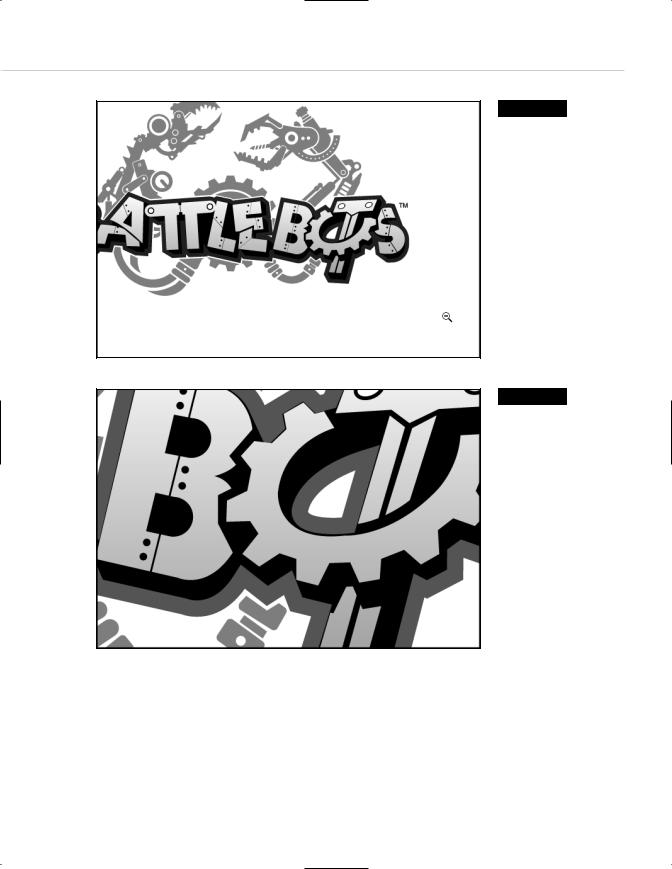
- •Taking Your Talent to the Web
- •Introduction
- •1 Splash Screen
- •Meet the Medium
- •Expanding Horizons
- •Working the Net…Without a Net
- •Smash Your Altars
- •Breath Mint? Or Candy Mint?
- •Where’s the Map?
- •Mars and Venus
- •Web Physics: Action and Interaction
- •Different Purposes, Different Methodologies
- •Web Agnosticism
- •Point #1: The Web Is Platform-Agnostic
- •Point #2: The Web Is Device-Independent
- •The 18-Month Pregnancy
- •Chocolatey Web Goodness
- •’Tis a Gift to Be Simple
- •Democracy, What a Concept
- •Instant Karma
- •The Whole World in Your Hands
- •Just Do It: The Web as Human Activity
- •The Viewer Rules
- •Multimedia: All Talking! All Dancing!
- •The Server Knows
- •It’s the Bandwidth, Stupid
- •Web Pages Have No Secrets
- •The Web Is for Everyone!
- •Swap text and code for images
- •Prune redundancy
- •Cache as Cache Can
- •Much Ado About 5K
- •Screening Room
- •Liquid Design
- •Color My Web
- •Thousands Weep
- •Gamma Gamma Hey!
- •Typography
- •The 97% Solution
- •Points of Distinction
- •Year 2000—Browsers to the Rescue
- •Touch Factor
- •Appropriate Graphic Design
- •User Knowledge
- •What Color Is Your Concept?
- •Business as (Cruel and) Usual
- •The Rise of the Interface Department
- •Form and Function
- •Copycats and Pseudo-Scientists
- •Chaos and Clarity
- •A Design Koan: Interfaces Are a Means too Often Mistaken for an End
- •Universal Body Copy and Other Fictions
- •Interface as Architecture
- •Ten (Okay, Three) Points of Light
- •Be Easily Learned
- •Remain Consistent
- •Continually Provide Feedback
- •GUI, GUI, Chewy, Chewy
- •It’s the Browser, Stupid
- •Clarity Begins at Home (Page)
- •I Think Icon, I Think Icon
- •Structural Labels: Folding the Director’s Chair
- •The Soul of Brevity
- •Hypertext or Hapless Text
- •Scrolling and Clicking Along
- •Stock Options (Providing Alternatives)
- •The So-Called Rule of Five
- •Highlights and Breadcrumbs
- •Consistent Placement
- •Brand That Sucker!
- •Why We Mentioned These Things
- •The year web standards broke, 1
- •The year web standards broke, 2
- •The year web standards broke, 3
- •The year the bubble burst
- •5 The Obligatory Glossary
- •Web Lingo
- •Extranet
- •HTML
- •Hypertext, hyperlinks, and links
- •Internet
- •Intranet
- •JavaScript, ECMAScript, CSS, XML, XHTML, DOM
- •Web page
- •Website
- •Additional terminology
- •Web developer/programmer
- •Project manager
- •Systems administrator (sysadmin) and network administrator (netadmin)
- •Web technician
- •Your Role in the Web
- •Look and feel
- •Business-to-business
- •Business-to-consumer
- •Solve Communication Problems
- •Brand identity
- •Restrictions of the Medium
- •Technology
- •Works with team members
- •Visually and emotionally engaging
- •Easy to navigate
- •Compatible with visitors’ needs
- •Accessible to a wide variety of web browsers and other devices
- •Can You Handle It?
- •What Is the Life Cycle?
- •Why Have a Method?
- •We Never Forget a Phase
- •Analysis (or “Talking to the Client”)
- •The early phase
- •Design
- •Brainstorm and problem solve
- •Translate needs into solutions
- •Sell ideas to the client
- •Identify color comps
- •Create color comps/proof of concept
- •Present color comps and proof of concept
- •Receive design approval
- •Development
- •Create all color comps
- •Communicate functionality
- •Work with templates
- •Design for easy maintenance
- •Testing
- •Deployment
- •The updating game
- •Create and provide documentation and style guides
- •Provide client training
- •Learn about your client’s methods
- •Work the Process
- •Code Wars
- •Table Talk
- •XHTML Marks the Spot
- •Minding Your <p>’s and q’s
- •Looking Ahead
- •Getting Started
- •View Source
- •A Netscape Bonus
- •The Mother of All View Source Tricks
- •Doin’ it in Netscape
- •Doin’ it in Internet Explorer
- •Absolutely Speaking, It’s All Relative
- •What Is Good Markup?
- •What Is Sensible Markup?
- •HTML as a Design Tool
- •The Frames of Hazard
- •Please Frame Safely
- •Framing Your Art
- •<META> <META> Hiney Ho!
- •Search Me
- •Take a (Re)Load Off
- •WYSIWYG, My Aunt Moira’s Left Foot
- •Code of Dishonor
- •WYS Is Not Necessarily WYG
- •Publish That Sucker!
- •HTMHell
- •9 Visual Tools
- •Photoshop Basics: An Overview
- •Comp Preparation
- •Dealing with Color Palettes
- •Exporting to Web-Friendly Formats
- •Gamma Compensation
- •Preparing Typography
- •Slicing and Dicing
- •Rollovers (Image Swapping)
- •GIF Animation
- •Create Seamless Background Patterns (Tiles)
- •Color My Web: Romancing the Cube
- •Dither Me This
- •Death of the Web-Safe Color Palette?
- •A Hex on Both Your Houses
- •Was Blind, but Now I See
- •From Theory to Practice
- •Format This: GIFs, JPEGs, and Such
- •Loves logos, typography, and long walks in the woods
- •GIFs in Photoshop
- •JPEG, the Other White Meat
- •Optimizing GIFs and JPEGs
- •Expanding on Compression
- •Make your JPEGS smaller
- •Combining sharp and blurry
- •Animated GIFs
- •Creating Animations in ImageReady
- •Typography
- •The ABCs of Web Type
- •Anti-Aliasing
- •Specifying Anti-Aliasing for Type
- •General tips
- •General Hints on Type
- •The Sans of Time
- •Space Patrol
- •Lest We Fail to Repeat Ourselves
- •Accessibility, Thy Name Is Text
- •Slicing and Dicing
- •Thinking Semantically
- •Tag Soup and Crackers
- •CSS to the Rescue…Sort of
- •Separation of Style from Content
- •CSS Advantages: Short Term
- •CSS Advantages: Long Term
- •Compatibility Problems: An Overview
- •Working with Style Sheets
- •Types of Style Sheets
- •External style sheets
- •Embedding a style sheet
- •Adding styles inline
- •Fear of Style Sheets: CSS and Layout
- •Fear of Style Sheets: CSS and Typography
- •Promise and performance
- •Font Size Challenges
- •Points of contention
- •Point of no return: browsers of the year 2000
- •Absolute size keywords
- •Relative keywords
- •Length units
- •Percentage units
- •Looking Forward
- •11 The Joy of JavaScript
- •What Is This Thing Called JavaScript?
- •The Web Before JavaScript
- •JavaScript, Yesterday and Today
- •Sounds Great, but I’m an Artist. Do I Really Have to Learn This Stuff?
- •Educating Rita About JavaScript
- •Don’t Panic!
- •JavaScript Basics for Web Designers
- •The Dreaded Text Rollover
- •The Event Handler Horizon
- •Status Quo
- •A Cautionary Note
- •Kids, Try This at Home
- •The Not-So-Fine Print
- •The Ever-Popular Image Rollover
- •A Rollover Script from Project Cool
- •Windows on the World
- •Get Your <HEAD> Together
- •Avoiding the Heartbreak of Linkitis
- •Browser Compensation
- •JavaScript to the Rescue!
- •Location, location, location
- •Watching the Detection
- •Going Global with JavaScript
- •Learning More
- •12 Beyond Text/Pictures
- •You Can Never Be Too Rich Media
- •Server-Side Stuff
- •Where were you in ‘82?
- •Indiana Jones and the template of doom
- •Serving the project
- •Doing More
- •Mini-Case Study: Waferbaby.com
- •Any Size Kid Can Play
- •Take a Walk on the Server Side
- •Are You Being Served?
- •Advantages of SSI
- •Disadvantages of SSI
- •Cookin’ with Java
- •Ghost in the Virtual Machine
- •Java Woes
- •Java Woes: The Politically Correct Version
- •Java Joys
- •Rich Media: Exploding the “Page”
- •Virtual Reality Modeling Language (VRML)
- •SVG and SMIL
- •SMIL (through your fear and sorrow)
- •Romancing the logo
- •Sounds dandy, but will it work?
- •Promises, Promises
- •Turn on, Tune in, Plug-in
- •A Hideous Breach of Reality
- •The ubiquity of plug-ins
- •The Impossible Lightness of Plug-ins
- •Plug-ins Most Likely to Succeed
- •Making It Work: Providing Options
- •The “Automagic Redirect”
- •The iron-plated sound console from Hell
- •The Trouble with Plug-ins
- •If Plug-ins Run Free
- •Parting Sermon
- •13 Never Can Say Goodbye
- •Separation Anxiety
- •A List Apart
- •Astounding Websites
- •The Babble List
- •Dreamless
- •Evolt
- •Redcricket
- •Webdesign-l
- •When All Else Fails
- •Design, Programming, Content
- •The Big Kahunas
- •Beauty and Inspiration
- •Index

352 HOW: Beyond Text/Pictures: Rich Media
Now that you know what VRML is, you probably don’t need to know much more about it. If you’re curious, more information is available at The Web Developer’s Virtual Library:
http://wdvl.internet.com/Authoring/VRML/
SVG and SMIL
In the absence of finalized multimedia standards for the Web, plug-ins were developed that enabled websites to offer streaming video, animated vector graphics, music tracks, and the like. We are about to look at those very plug-ins. But first, let us pause to consider a recent development.
Over the past couple of years, W3C recommendations have emerged to suggest standardized ways of doing what proprietary plug-ins already do so well. One of these is SMIL, the W3C recommendation for multimedia; the other is SVG, intended to deliver vector graphics such as those already used in Flash (but with some essential differences from Flash).
What’s up with these two new standards, and why do they matter?
SMIL (through your fear and sorrow)
SMIL (http://www.w3.org/AudioVideo/) stands for Synchronized Multimedia Integration Language and is pronounced, “smile.” Isn’t that cute? Oh, shut up.
SMIL is an easy-to-learn, HTML-like language for creating “TV-like multimedia presentations such as training courses on the Web,” according to the W3C. The current SMIL recommendation is 1.0, and you can read all about it at the W3C address just cited and at another one we’ll mention later. This is our way of avoiding adding another 50 pages to this book.
Aside from the fact that three Internet heavies (Real, Apple, and Adobe) are throwing their weight behind SMIL, why should you care about any of this? Let’s see.
Harnessing media, helping users
SMIL packs accessibility features (http://www.w3.org/TR/SMIL-access/), including alternative text content that can be made available to Braille readers. Such content will also enable search engines to index multimedia web content authored in SMIL.

Taking Your Talent to the Web |
353 |
In English: slap a QuickTime video on your site and search engines such as Google or Altavista could care less. But add a carefully authored SMIL presentation to your site, and speeches made by the characters in your video could show up in Google and Altavista’s search results.
The educational implications are enormous. A student researching Hamlet’s soliloquy could find a SMIL-authored video of Sir Laurence Olivier performing it. The Web’s potential as the world’s library could suddenly become much richer.
The commercial implications ain’t bad, either. A buyer searching for widgets could find your client’s digitized promotional video on the subject. Existing multimedia formats obviously do not offer these advantages.
Lest you think SMIL is a completely wacky new technology, it is, in fact, simply a markup language that works with existing technologies like QuickTime and Real digital video and audio. What SMIL does is bring the traditional benefits of the Web (searching, finding, bookmarking) to nontext content. That is profound.
More reasons to SMIL
Other cool things you can do with SMIL:
1.With a single link, you can deliver audio to dialup users and video to broadband users. None of that “click here for audio, click here for video” junk.
2.Deliver different language versions of clips depending on a user’s system-language setting.
3.Use back-end technologies to deliver multimedia content on the fly. No need for expensive, proprietary programs with steep learning curves. (SVG delivers similar benefits.)
…All with a few simple tags.
Author! Author!
Among the currently available Web tools and plug-ins that support SMIL are Apple QuickTime 4.1 (http://www.apple.com/quicktime/) and the unfortunately named RealSlideshow authoring tool by the makers of

354 HOW: Beyond Text/Pictures: Rich Media
the RealPlayer (http://proforma.real.com/rn/tools/slideshow/index.html?). Adobe is presently developing a SMIL extension for its GoLive WYSIWYG tool, which should simplify the creation of SMIL content and might help accelerate the standard’s adoption.
RealSystem’s support for SMIL has been solid since 1998. Given the number of RealPlayers out there, SMIL can already reach almost as many web users as Flash does. Not that SMIL and Flash are enemies. SMIL is often used to integrate Flash content into the QuickTime and RealPlayers, and Flash 5 exports SMIL for use in RealSystem.
SMILsoftware’s Flution 1.5 (http://www.smilsoftware.com/) for Windows can streamline the SMIL creation process. Tom Wlodkowksy’s free Media Access Generator (MAGpie) for Windows (http://main.wgbh.org/wgbh/ pages/ncam/webaccess/magpie/) adds accessibility features such as closed-captioning to SMIL. For a more detailed description of the goals of the SMIL language, see the W3C Activity Statement (http://www.w3.org/ AudioVideo/Activity.html) on Synchronized Multimedia. For practical advice on putting SMIL to work, see Jim Heid’s old-but-good tutorial at Macworld, SMIL: Markup for Multimedia (http://macworld.zdnet.com/ 2000/02/create/markupmultimedia.html).
SVG for You and Me
SVG (Scalable Vector Graphics) is a W3C standard in progress. As of this writing, the W3C describes its initial SVG activities as “currently nearing completion” (http://www.w3.org/Graphics/SVG/Overview.htm8). Though SVG produces vector graphics, it is a markup language. In fact, it is an application of XML, the super-meta-markup language we’ve mentioned throughout this book.
Like Flash vector graphics, SVG vector graphics can fill an entire screen with artwork while using very little bandwidth. Also like Flash, SVG can be animated via scripting. You’ll find examples of this at Adobe’s SVG site, which we’ll discuss in a moment (see Figures 12.5 and 12.6).

Taking Your Talent to the Web |
355 |
Figure 12.5
The Battlebots logo in SVG. At the user’s discretion, the image can be enlarged again and again.
Figure 12.6
Vector artwork maintains quality at the highest magnifications while keeping bandwidth expenditure at a minimum (http:// www.adobe.com/).
No matter its graphic appearance, SVG remains text. To understand the implications of that fact, let’s contrast SVG with our present production techniques. We’ll use an example that’s close to every designer’s heart: the client’s logo.
